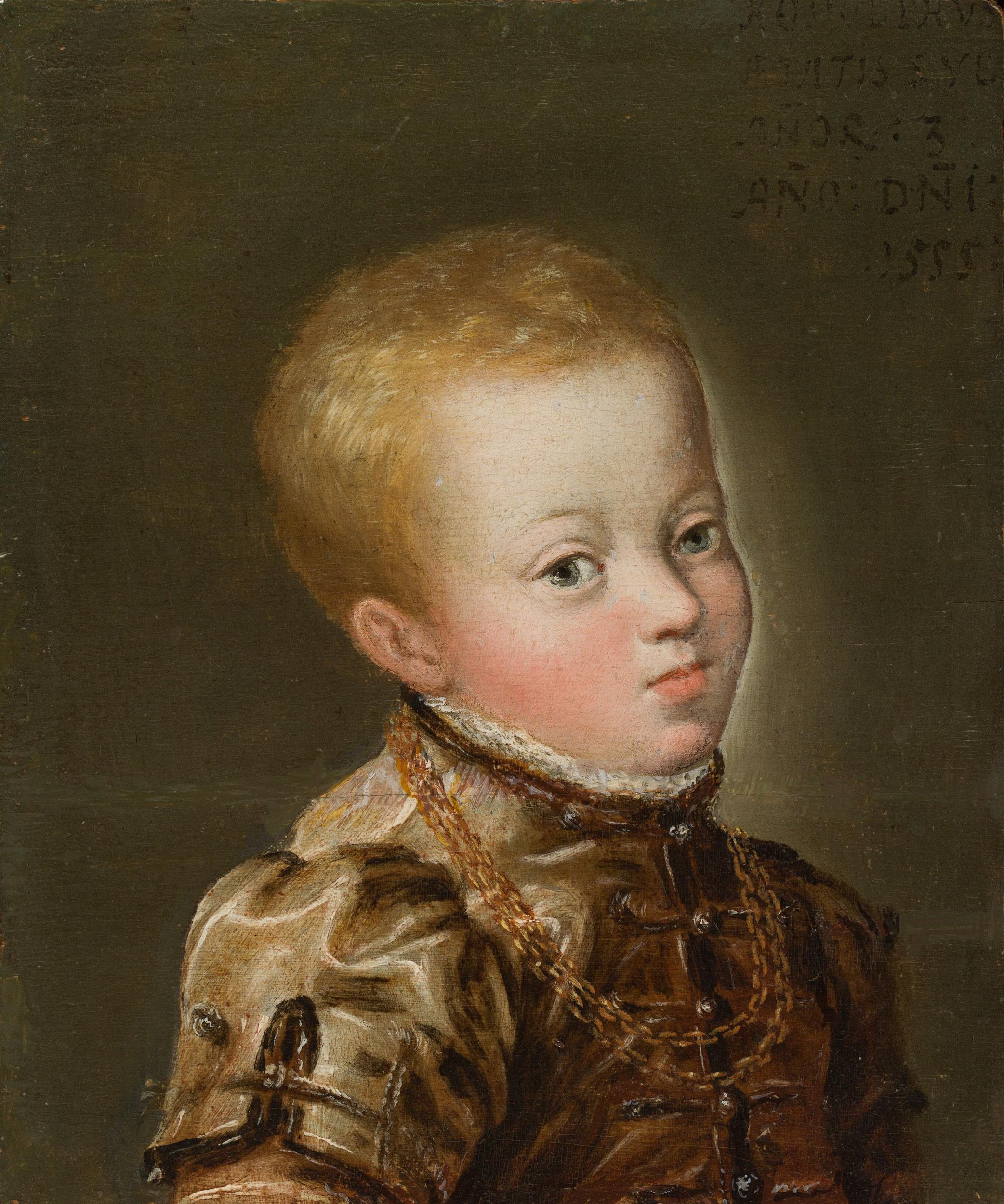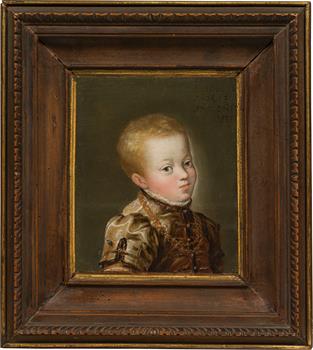2167
Circle of Jakob Seisenegger
„Portrait of Emperor Rudolf II at the age of three“
1555
oil on panel; parqueted; framed
18 x 15 cm
inscribed and dated partly illegibly in the upper right: RODOLPHUS / AETATIS SVE / ANOR: 3: / ANO : DNI : / 1555:
Provenance
Galerie St. Lucas, Vienna, 1936;
Frederick Mont/Adolf Fritz Mondschein, New York, 1950;
private collection Karl (Charles) Baron Neuman de Végvár (1883-1959) and Edith Neuman de Végvár (1893-1984), Greenwich (Connecticut);
Erna Neuman de Végvár (1923-2002), New York, from 1989;
estate of Rudolf von Strasser, Vienna
Exhibition
1950 Baltimore, The Baltimore Musem of Art, "Behold the Child";
1988/89 Vienna, Kunsthistorisches Musem, no. 592
Literature
Behold the Child, exhibition catalogue, The Baltimore Museum of Art, Baltimore 1950, p. 6 (as Jakob Seisenegger, "Portrait of Hapsburg Prince");
Kurt Löcher, Jakob Seisenegger. Hofmaler Kaiser Ferdinands I., Kunstwissenschaftliche Studien vol. 31, Linz 1962, p. 104, no. 123 (attributed to Francesco Terzio);
Claus Virch, Paintings in the Collection of Charles and Edith Neuman de Végvár, New York 1970, p. 24 (as Jacob Seisenegger);
Prag um 1600. Kunst und Kultur am Hofe Kaiser Rudolfs II., exhibition catalogue, Kunsthistorisches Museum, Vienna, vol. 2, Freren 1988, p. 123, no. 592, b/w-ill. (as unknown artist)
Estimate: € 10.000 - 20.000
Auction is closed.
As the third child of Emperor Maximilian II (1527-1576) and his wife Mary of Spain (1528-1603), Rudolf became heir to the throne of the Roman-German Empire. The first-born son Ferdinand died in early childhood (1552). His elder sister Anna (1549-1580), according to tradition, had no claim to the throne of the imperial house. The Habsburgs' courtly portrait culture paid particular attention to children's portraits, as they were intended to convey the legitimacy of the rule, social status and reputation of the hereditary princes and princesses. The court painter Jakob Seisenegger (1505-1567) had already been entrusted with portraits of the descendants of Emperor Ferdinand I. His courtly portraits must be regarded as type-forming images. It is therefore not surprising that the present portrait of Rudolf was also attributed to Seisenegger in the past - after all, Seisenegger had already portrayed his father Maximilian in childhood years before.
Little Rudolf is identified in this portrait by an inscription in the upper right background. The artist was a master at combining the demands of an official portrait with the naturalness of a child. The rosy cheeks, delicate features and large eyes correspond to the physiognomy of a three-year-old. The similarities, such as the delicately curved mouth, the iridescent incarnate parts, the highlights in the hair and the modelling light, to Seisenegger's "Archduchess Eleonore (1534-1594), Duchess of Mantua as a Two-Year-Old" (KHM, Vienna, Gemäldegalerie, 872) cannot be denied.
Rudolf, however, directs his gaze directly at the viewer and not unconcernedly past them, as is typical of early courtly portraits of children. Here, too, the static posture and the noble garments convey the dignity and position of the hereditary prince. What is striking, however, is the simple drawing of the gold chain and the almost sketch-like handling of the robe fabric. Probably because of this technique, Kurt Löcher attributed the "lightly thrown, Venetian-style" painting in 1962 to the Bergamo painter Francesco Terzio (1523-1591), who also worked at the court of Maximilian II and portrayed numerous members of the Habsburg imperial family.
The type of portrait of the filial archduke shows striking similarities with the representation of him in the group portrait "Emperor Maximilian II and his Family" (c. 1553/54; KHM Vienna, Inv. No. 3448), which was also formerly attributed to Terzio, but is now attributed to Giuseppe Arcimboldo (1527-1593). That execution of the prince turned to the right, depicted in a playful and lively manner appropriate to his age, "is, however, different from the sketchy, light, painterly, open and loose manner of painting according to the Venetian model" of the present child portrait (cf. Prague c. 1600).


